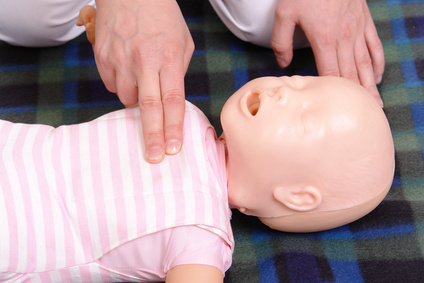When to Activate Emergency Response System
Witnessed Collapse: Follow steps for Adults and Adolescents
Unwitnessed Collapse: Provide 2 minutes of CPR. Leave victim to activate the Emergency Response System and retrieve an AED (unless you can have someone else activate the response). Return and resume CPR and use an AED if it is available.
Infant CPR (Age Less than 1 Year, Excluding Newborns)
Scene Safety and Recognition of Cardiac Arrest: Check for safety and responsiveness, no breathing, and gasping. Check pulse for more than 5 seconds but within 10 seconds (breathing and pulse check can occur simultaneously).
Check Pulse: Check the infants pulse by placing 2 fingers on the brachial artery. Press your index and 3rd finger on the inside of the infant’s upper arm between the elbow and shoulders.
C is for Circulation – Infant Compressions
Circulation: Chest compressions circulate the blood within the patient. It's important to place your hands correctly upon the patient’s chest. Chest Compression Tempo: The correct tempo that should be performed matches the song “Staying Alive.” Make sure to push hard and fast to that song’s tempo. Use EXTREME caution when providing CPR on infants.
One Rescuer: Just below the infant's nipples, in the center of the chest, and just below the middle horizontal line, place two fingers for compression. Remember, 100-120/min compressions while maintaining the same ratio 30:2 Compression to Breathing: Perform five reps of Compressions and breathing or about 2 minutes and then call 911 (or have someone else activate the emergency response system). Continue CPR until help arrives or until the infant breathes again. Press compressions at about 1/3 of the chest circumference (at least one-third AP diameter of chest or about 1.5 inches or 4 cm.)
Two Rescuers: One Rescuer should use two hands holding the infant facing up while positioning the fingers (encircling hands) in the middle of the infant’s chest as the other rescuer uses a one-way valve—placing it over the infant’s mouth and nose. One rescuer will perform compressions while the other uses the rescue valve. You can also apply a ratio of 15:2 compressions to breathing. Give one breath every 6 seconds (10 breaths/min) if an advanced airway technique is used.
Compression-ventilation ratio without Advanced Airway
-
One Rescuer - 30:2
-
Two or more Rescuers - 15:2
Compression-ventilation ratio with Advanced Airway
- Continuous compressions at a rate of 100-120/min
- One breath every 6 seconds (10 breaths/min)
A is for Airway – Clear the Airway
Airway: Make sure to lay the infant on a firm, solid surface as you would with children and adults. Kneel beside the infant’s shoulder while placing one hand on the infant’s forehead as your other hand gently lifts the chin. Next, listen and feel for any breathing for 10 seconds. Place your cheek just in front of the infant’s mouth while checking for a pulse under the upper arm. If the infant isn’t showing any signs of life, begin the breathing technique.
B is for Breathing – Mouth-to-Mouth
Breathing into an infant is different than breathing into an adult or child.
Breathing: Place your entire mouth over the infant’s mouth and nose when you breathe into the infant. Make sure to perform this task with less breath than you would with children or adults. If the chest fully recoils, complete the second breath (each for one second). Check for anything blocking the airway if the chest doesn't rise completely and repeat the process.
Once the breathing technique is applied, continue Circulation, Airway, Breathing (C-A-B’s).
Rescuers Should Never
- Compress slower than 100/min or faster than 120/min
- Compress in-depth less than 1 and 1/2 inches (4 cm)
- Lean on the victim’s chest during compressions
- Allow interruption during compressions for more than 10 seconds
- Provide excessive ventilation during breathing task (i.e., excessive breathing with force or too many breaths)
- Check the environment and make sure it’s safe for rescuers and victims
- Remove any physical obstructions in the immediate area (i.e., belongings, debris, small pieces of furniture)
- Check responsiveness
- No breathing or only gasping (no normal breathing)
- 3. Within 10 seconds (no positive pulse)
- You can check for a pulse and breathing simultaneously in less than 10 seconds
- Witnessed collapse: Leave the victim, if you’re alone without a mobile phone. Activate the emergency response system while retrieving an AED before performing CPR
- Unwitnessed collapse: Give 2 minutes of CPR. Activate the emergency response system. Get an AED and return to the victim. Resume CPR and use the AED as soon as it is available
- One rescuer: 30:2
- Two or more rescuers: 15:2
- Chest compressions – 100-120/min
- Give 1 breath every 6 seconds (10 breaths/min)
- 100-120/min
- At least 1/3 AP diameter of chest
- About 1½ inches (4 cm)
- One rescuer: Just below the nipple line with 2 fingers in center of chest
- Two or more rescuers: Two thumbs (encircling hands) in the center of the chest just below the nipple line
- Make sure not to lean on the chest of the victim and allow a full recoil after each chest compression
- Compression interruptions should be limited to less than 10 seconds




